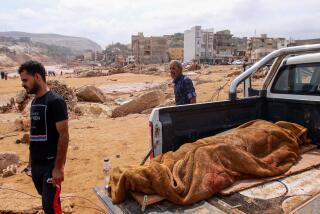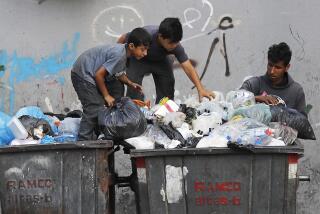Gas lines and empty roads in an oil-producing nation
- Share via
Reporting from Tripoli, Libya — Traveling the coastal route from Tunisia to Tripoli, Libya’s capital, one thing became clear: One of Africa’s largest oil producers has become home to some of the world’s longest gasoline lines.
At some stations in western Libya, cars stretched for a mile or more during rush hour Monday afternoon, and in one case at least two miles. At several stations, the queues snaked through main avenues and onto side streets, blocking vehicles trying to get through. Men with rifles helped keep order, though motorists argued with one another and with the security personnel.
Many stations had no gasoline to sell, yet the lines still stretched for blocks. In those cases, drivers simply left their vehicles and walked away, reserving a space until — or if — supplies were replenished.
Across the border in Tunisia, merchants were selling 2-liter jugs of gasoline to the petrol-starved. The new industry was flourishing, though apparently not fast enough to fill the roads. Relatively few trucks were seen on the 100-mile stretch from the Ras Ajdir border crossing to Tripoli, normally a major route for imports and exports. In the capital, cars sped along the main highway without slowdown.
Life has changed dramatically in Libya in the three months since an uprising began against the regime of Moammar Kadafi. The international embargo that followed the strongman’s crackdown on protesters has choked off imports, causing a crisis in a country where gasoline had long been plentiful and cheap — less than 50 cents a gallon. The North African nation has limited refining capacity and imports much of its refined gasoline and diesel.
Libyan rebels in the east and others seeking Kadafi’s ouster hope the fuel shortages and other hardships will motivate people in the west to rise up against him. Without replacement fuel, power outages loom as the scalding North African summer approaches.
But what will happen next in Libya is unpredictable, and the coastal route provides only a narrow snapshot of the vast region west of Tripoli.
On this day, on a two-hour journey via press ministry bus, the road was devoid of military vehicles, probably in response to NATO’s air attacks. Government troops were using mostly pickup trucks.
Checkpoints were frequent and typically staffed by a few young soldiers, except for the more heavily manned stops closer to Tripoli.
At points along the highway, earthen berms had been thrown up in parallel rows alongside the road, apparently for defense.
There were no signs of NATO bombing damage. Cellphone towers were intact, as were at least one major refinery and several factories. NATO has said its airstrikes are hitting military targets, but Libya has accused the alliance of targeting telecommunications and other civilian infrastructure.
In Zuwarah, a town about 70 miles west of the capital, several buildings along the main drag were heavily damaged from what appeared to be street battles. Few pedestrians could be seen and most shops were closed.
The road also passes through a swath of Zawiya, a city just west of the capital that was the scene of fierce fighting and a brutal government crackdown. Though no damage was visible this day, a journalist who had been there weeks earlier said much of the destruction was in the downtown area.
Throughout the drive to Tripoli, many of the roadside stores were shuttered, though goods appeared plentiful at vegetable stands and other shops that were open.
People who gathered early Tuesday at the fiery site of two bombed government office buildings said they were shocked and terrified that such destructive power was being unleashed almost nightly on the city. Somebody asked where it would end. There was no good answer.
More to Read
Sign up for Essential California
The most important California stories and recommendations in your inbox every morning.
You may occasionally receive promotional content from the Los Angeles Times.










